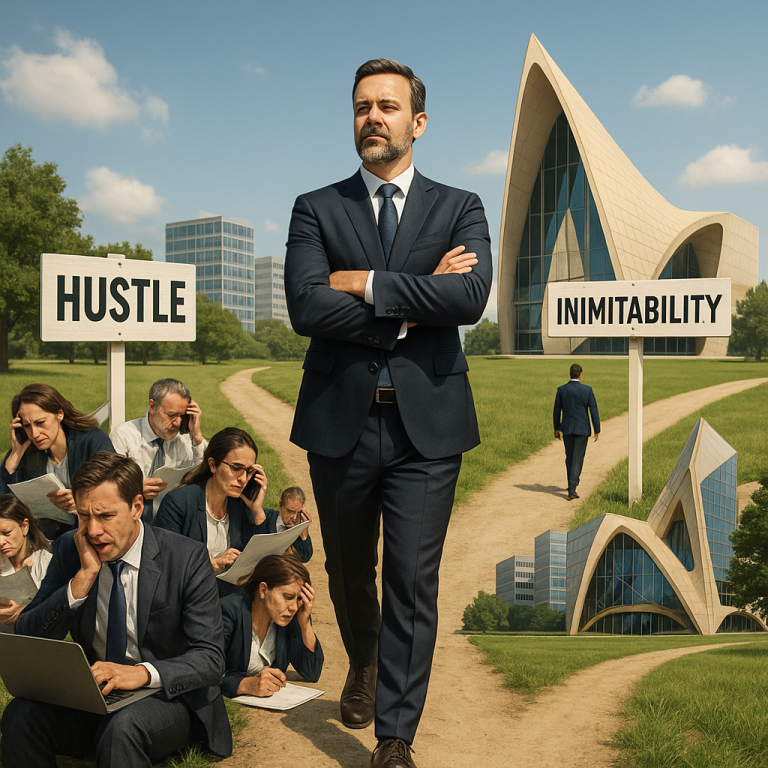The ultimate test of leadership isn’t what happens when you’re in the room—it’s what happens when you’re not.
I learned this lesson the hard way. After building my first company from startup to successful acquisition, I took a three-week vacation to celebrate. When I returned, I discovered that critical decisions had been postponed, opportunities had been missed, and momentum had been lost. The organization I had built couldn’t function without me constantly at the helm.
That experience taught me a profound truth: If your organization depends on your daily presence to succeed, you haven’t built an organization—you’ve built a job. And if you’re leading a team, division, or company that collapses without your constant attention, you haven’t created something that can scale, sustain, or ultimately succeed long-term.
The Self-Sustaining Organization Paradox
Here’s the paradox that every leader must eventually confront: Your greatest success comes when you make yourself unnecessary. The most valuable organizations aren’t built around individual leaders—they’re designed to thrive regardless of who occupies specific positions.
This runs counter to how many leaders operate. We naturally want to feel essential. We derive satisfaction from being needed. We enjoy the ego boost that comes when problems require our unique expertise to solve. Yet this very tendency creates organizational dependency that ultimately limits growth and sustainability.
Building a self-sustaining organization doesn’t mean making yourself irrelevant. Rather, it means creating a system where your value shifts from daily decision-making to strategic architecture and capability development. The question evolves from “What problems can I solve?” to “What systems can I design that solve problems without my direct involvement?”
The Five Pillars of Self-Sustaining Organizations
Through working with dozens of executives across industries, I’ve identified five critical elements that create truly self-sustaining organizations:
1. Distributed Decision Authority
In organizations dependent on leaders, decision-making power concentrates at the top. Information flows up, decisions flow down, and bottlenecks inevitably form. When the decision-maker is unavailable, progress stalls.
Self-sustaining organizations distribute decision authority to where information naturally lives. They establish clear decision frameworks rather than requiring approval chains. They create transparency around who decides what, using approaches like:
- Documented decision rights matrices that clearly establish who has authority for which decisions
- Decision protocols that outline how different types of decisions should be made
- Authority thresholds that empower people to act within established boundaries
- Decision retrospectives that evaluate outcomes and refine the process
Shopify offers a master class in distributed decision-making. Their “decision making as a service” model provides clear frameworks while pushing authority to the edges of the organization. Teams operate with significant autonomy within established guardrails, allowing the company to maintain its entrepreneurial spirit despite significant growth.
The key isn’t abdicating responsibility but creating contexts where good decisions happen naturally. As one CEO told me, “My job isn’t to make all the decisions—it’s to create the conditions where the right decisions get made without me.”
2. Self-Replicating Culture
Dependent organizations have cultures that reflect whatever the leader happens to value that day. Self-sustaining organizations have cultures that replicate themselves through intentional systems.
Culture isn’t about office perks or mission statements—it’s about how decisions get made when no one is watching. It’s the set of unspoken rules that guide behavior in ambiguous situations. When culture depends on a leader’s presence, it erodes the moment they step away.
Creating a self-replicating culture requires:
- Explicitly defined and consistently reinforced values that guide behavior
- Cultural onboarding processes that acculturate new members effectively
- Recognition systems that celebrate behaviors aligned with core values
- Storytelling mechanisms that transmit cultural lessons throughout the organization
- Cultural maintenance processes that address violations consistently
Netflix exemplifies this approach through its famous culture deck and subsequent practices. The company doesn’t just articulate values—it builds systems that replicate them across the organization, from hiring practices to feedback mechanisms to compensation structures.
One particularly effective practice is creating cultural catchphrases that encapsulate complex principles in memorable language. These phrases become decision shortcuts that guide behavior even when leaders aren’t present to interpret them.
3. Capability Systems, Not Capability Heroes
Dependent organizations rely on individual heroes with specialized capabilities. When those heroes leave or become unavailable, capabilities disappear with them.
Self-sustaining organizations build capability systems that develop, distribute, and preserve crucial skills throughout the organization. These systems ensure that essential capabilities become organizational assets rather than individual attributes.
Effective capability systems include:
- Knowledge management platforms that capture and share critical information
- Skill development programs that continuously build bench strength
- Cross-training initiatives that distribute capabilities across multiple people
- Documentation practices that transform tacit knowledge into explicit resources
- Mentoring structures that facilitate capability transfer between individuals
Toyota’s production system represents this principle in action. Rather than depending on individual manufacturing experts, the company created a comprehensive system that embeds expertise into standardized processes, training protocols, and continuous improvement mechanisms.
The shift from capability heroes to capability systems requires overcoming the “bus factor” problem—the number of people who could get hit by a bus before a capability would be lost. Organizations with low bus factors are inherently fragile; those with high bus factors demonstrate sustainable capability.
4. Self-Correcting Feedback Loops
Dependent organizations rely on leaders to identify and correct problems. Self-sustaining organizations build feedback mechanisms that detect and address issues automatically.
These feedback loops create organizational homeostasis—the ability to maintain stability despite changing conditions. Like a thermostat that adjusts temperature without human intervention, effective feedback systems maintain organizational health without requiring constant leadership attention.
Key elements of self-correcting feedback loops include:
- Real-time performance metrics visible to those doing the work
- Regular retrospective practices built into operational rhythms
- Customer feedback channels that reach the people who can implement changes
- Cross-functional communication structures that prevent silos
- Decision review processes that evaluate outcomes against intentions
Amazon’s “working backwards” process exemplifies this approach. By starting with the customer experience and building internal accountability mechanisms around it, the company created self-correcting systems that maintain quality even as it scaled tremendously.
The most powerful feedback loops connect consequences directly to decisions, creating natural incentives for appropriate behavior. When people experience the results of their choices immediately, they adjust without requiring management intervention.
5. Regenerative Leadership Development
Dependent organizations have leadership gaps behind current leaders. Self-sustaining organizations continuously develop leadership at all levels, ensuring seamless transitions when people move on.
Regenerative leadership development doesn’t just prepare successors for current positions—it creates a leadership ecosystem that continuously replenishes itself. This approach treats leadership development as a systemic function rather than a series of individual career paths.
Effective regenerative leadership systems include:
- Leadership identification processes that spot potential early
- Development pathways that provide progressive leadership experiences
- Rotation programs that build broad organizational understanding
- Mentoring structures that transmit wisdom between leadership generations
- Succession planning processes for all key positions, not just executive roles
Procter & Gamble has historically excelled at regenerative leadership, creating development systems that produce not just their own future executives but leaders for organizations throughout their industry. Their “promote from within” philosophy is supported by comprehensive development systems that ensure leadership continuity.
The most sustainable leadership development approaches focus not just on preparing individuals for specific roles but on building a leadership mindset throughout the organization. When leadership becomes a distributed function rather than a position, the organization develops remarkable resilience.
Implementing the Self-Sustaining Model
Building a self-sustaining organization isn’t a theoretical exercise—it requires concrete implementation steps. Here’s how leaders can begin the transformation:
Phase 1: Honest Dependency Assessment
Start by conducting a clear-eyed evaluation of organizational dependencies:
- Map decision flows to identify bottlenecks centered around specific individuals
- Document critical knowledge and skills possessed by single people
- Track postponed decisions when key individuals are unavailable
- Identify processes that fail or degrade when certain people are absent
- Gather anonymous feedback about dependency challenges
The goal isn’t to place blame but to create visibility into dependencies that limit organizational capability. As one executive told me, “You can’t address dependencies you refuse to acknowledge.”
Phase 2: Dependency Reduction Strategy
With a clear dependency map, develop specific strategies to address each area:
- Create decision frameworks for frequently occurring choices
- Document critical processes and knowledge currently held by individuals
- Develop cross-training plans for key capabilities
- Design feedback systems for critical performance areas
- Implement succession planning for all essential roles
Prioritize based on risk—address dependencies that pose the greatest threat to organizational sustainability first, then work through the remainder systematically.
Phase 3: System Design and Implementation
Convert dependency reduction strategies into operational systems:
- Redesign workflows to distribute decision authority appropriately
- Implement knowledge management systems to capture critical information
- Create training programs to distribute essential capabilities
- Build feedback mechanisms into regular operations
- Formalize leadership development as an ongoing organizational function
The key is moving from leader-dependent processes to system-driven operations. As one CEO explained, “We stopped asking ‘Who will handle this?’ and started asking ‘What system will handle this?'”
Phase 4: Graduated Testing
Test the self-sustaining capacity through progressive leadership absence:
- Begin with short planned absences with limited communication
- Extend to longer periods of unavailability
- Eventually test complete disconnection for designated periods
- Conduct thorough after-action reviews to identify remaining dependencies
- Refine systems based on performance during leadership absence
These planned “sustainability tests” provide safe opportunities to identify and address remaining dependencies before they create crisis situations.
Phase 5: Continuous Reinforcement
Finally, build mechanisms that continuously reinforce self-sustaining capacity:
- Celebrate examples of autonomous operation and problem-solving
- Share stories of successful function during leadership absence
- Reward innovations that reduce organizational dependencies
- Regularly review and refine self-sustaining systems
- Incorporate sustainability measures into performance evaluation
The transition to a self-sustaining organization isn’t a one-time event but an ongoing process of reinforcing independence and system-thinking throughout the organization.
The Personal Challenge for Leaders
Building a self-sustaining organization presents not just operational challenges but personal ones. Many leaders struggle with the psychological transition from being needed to creating systems that make their daily involvement unnecessary.
This requires a profound identity shift. Your value becomes less about the problems you solve and more about the problem-solving systems you create. Your impact comes not from personal heroics but from architectural decisions that enable others to succeed without you.
This transition often triggers uncomfortable questions: If they don’t need me anymore, what’s my value? If the organization can function without me, what’s my purpose? These concerns, while natural, reflect an outdated understanding of leadership.
True leadership lies not in creating dependency but in building capacity that extends beyond your direct influence. Your greatest contribution isn’t solving today’s problems but creating systems that solve tomorrow’s challenges—even those you can’t anticipate today.
The Ultimate Leadership Legacy
The most telling test of leadership isn’t what happens during your tenure—it’s what happens after you’re gone. Organizations that collapse when founders or key leaders depart reveal the limitations of personality-dependent leadership. Those that continue thriving demonstrate the power of systemic approaches.
Building a self-sustaining organization doesn’t diminish your impact—it multiplies it. By creating systems rather than dependencies, you extend your influence far beyond what personal intervention could achieve. Your leadership becomes embedded in the organization’s DNA rather than dependent on your daily decisions.
The paradox resolves itself: By making yourself unnecessary in daily operations, you make yourself invaluable as an organizational architect. By designing an organization that doesn’t need you, you create your most enduring leadership legacy—a living system that continues winning long after you’ve moved on to new challenges.
Rather than asking, “How can I be essential to this organization?” start asking, “How can I make this organization capable of thriving without me?” The answer to that question doesn’t diminish your leadership—it defines it.



